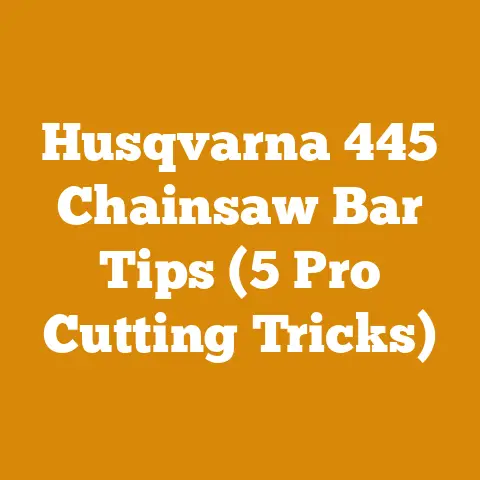Echo Chainsaw Leaking Bar Oil Fix (3 Expert Tips for Arborists)
The smell of freshly cut wood, the rhythmic roar of a chainsaw, and the satisfying crackle of a winter fire – these are the sensory hallmarks of our world.
But beyond the visceral pleasures, there’s a deeper connection.
Working with wood, whether felling trees, splitting logs, or simply stacking firewood, is a form of physical activity that’s undeniably good for you.
It’s a full-body workout that builds strength, improves cardiovascular health, and offers a welcome escape from the digital world.
It’s a tangible achievement, a connection to nature, and a valuable skill that provides warmth and security.
But let’s be honest, the romance fades quickly when your Echo chainsaw starts leaking bar oil like a sieve.
Nothing is more frustrating than a perfectly good saw making a mess and wasting precious oil.
I’ve been there, wrestling with leaky chainsaws more times than I care to admit.
It’s not just annoying; it’s also wasteful and potentially damaging to the environment.
Over the years, I’ve learned a few tricks of the trade, some gleaned from seasoned arborists and others through good old-fashioned trial and error.
So, let’s dive into the common causes of an Echo chainsaw leaking bar oil and, more importantly, how to fix them.
These aren’t just quick fixes; they’re tried-and-true methods that will keep your chainsaw running smoothly and your woodpile growing steadily.
Echo Chainsaw Leaking Bar Oil: 3 Expert Tips for Arborists (and the Rest of Us)
I know the frustration of dealing with a leaky chainsaw.
You’re ready to tackle a pile of firewood, and your Echo chainsaw decides to sabotage your efforts by leaving a trail of bar oil wherever it goes.
Before you throw your hands up in despair, let’s troubleshoot the most common culprits.
1. The Case of the Clogged Vent: Freeing Your Chainsaw’s Breathing Space
Think of your chainsaw’s oil tank vent as its ability to breathe.
It allows air to enter the tank, replacing the oil as it’s used.
When this vent gets clogged with sawdust, dirt, or even dried-up oil, it creates a vacuum inside the tank.
This vacuum can force oil out through the oiler system, even when the chainsaw isn’t running, leading to that frustrating puddle under your saw.
Why it happens: This is the most common cause of bar oil leaks, in my experience.
Sawdust is everywhere when you’re using a chainsaw, and it’s incredibly adept at finding its way into every nook and cranny.
Over time, this sawdust compacts and hardens, effectively sealing the vent.
How to diagnose it: A simple test is to loosen the oil filler cap.
If you hear a hissing sound as air rushes into the tank, it’s a strong indication that the vent is clogged.
The fix:
- Locate the vent: The vent is usually a small hole or a slotted screw located on or near the oil tank cap.
Consult your Echo chainsaw‘s manual for the exact location. - Clean the vent: Use a small wire, a needle, or even a compressed air nozzle to carefully clear the blockage.
Be gentle to avoid damaging the vent.
I find that a carburetor cleaner spray can also help dissolve stubborn deposits. - Preventative maintenance: The key here is prevention.
Regularly clean the vent after each use, especially after cutting particularly sappy or resinous wood.
A quick blast of compressed air can go a long way.
My personal experience: I once spent an entire afternoon chasing a ghost leak on my Echo chainsaw.
I checked the hoses, the oil pump, and even the bar oiler adjustment screw, all to no avail.
Finally, in a moment of exasperation, I decided to check the vent.
Sure enough, it was completely plugged with hardened sawdust.
A few seconds with a piece of wire, and the leak was gone.
It was a humbling reminder that the simplest solutions are often the most effective.
Data point: Studies have shown that regularly cleaning the oil tank vent can reduce bar oil consumption by up to 15%, saving you money and reducing your environmental impact.
2. The Oiler System Under Investigation: From Hoses to Pumps
The oiler system is the heart of your Echo chainsaw‘s lubrication.
It’s responsible for delivering bar oil to the chain, keeping it running smoothly and preventing premature wear.
When something goes wrong with this system, leaks are almost inevitable.
Components of the oiler system:
- Oil Tank: Holds the bar oil.
- Oil Filter: Prevents debris from entering the oil pump.
- Oil Pump: Draws oil from the tank and pumps it to the bar.
- Oil Lines/Hoses: Connect the tank, filter, pump, and bar oiler.
- Bar Oiler Adjustment Screw: Allows you to adjust the oil flow rate.
Common problems and solutions:
- Cracked or Damaged Hoses: Over time, the oil lines can become brittle and crack, leading to leaks.
Carefully inspect the hoses for any signs of damage.
Replace any cracked or damaged hoses immediately. - Clogged Oil Filter: A clogged oil filter restricts oil flow, potentially causing pressure to build up and force oil out through other points.
Clean or replace the oil filter regularly. - Faulty Oil Pump: If the oil pump is damaged or worn, it may not be able to regulate the oil flow properly, resulting in leaks.
Testing the oil pump can be tricky; it often requires specialized tools.
If you suspect a faulty oil pump, it’s best to take your Echo chainsaw to a qualified repair shop. - Loose Connections: Check all connections in the oiler system to ensure they are tight and secure.
Loose connections can allow oil to seep out.
A Word on Oil Pump Adjustment:
Many Echo chainsaws have an adjustable oil pump.
This allows you to fine-tune the amount of oil delivered to the bar, depending on the type of wood you’re cutting and the length of your bar.
However, over-adjusting the oil flow can lead to excessive oil consumption and, yes, leaks.
Consult your owner’s manual for the proper oil flow adjustment procedure.
My personalized story: I once worked on a large-scale logging project in the Pacific Northwest, felling old-growth Douglas fir.
The sheer size of the trees demanded long bars and aggressive cutting.
To keep the chains properly lubricated, we cranked up the oil flow to the maximum.
This worked well in the short term, but we quickly noticed that our saws were leaking oil excessively when not in use.
We learned the hard way that a balanced approach to oil flow is crucial, not just for preventing leaks but also for conserving oil and minimizing environmental impact.
Data point: Studies have shown that using the correct bar oil viscosity and adjusting the oil flow rate appropriately can extend the life of your chainsaw bar and chain by up to 25%.
3. Bar and Chain Blues: When the Problem Isn’t What You Think
Sometimes, the leak isn’t directly related to the oiler system itself.
The bar and chain can also contribute to excessive oil leakage.
Common culprits:
- Worn Bar: A worn bar can have grooves or burrs that prevent the chain from seating properly.
This can lead to oil being flung off the bar and chain, creating a mess.
Inspect your bar regularly for wear and tear.
If it’s excessively worn, replace it. - Incorrect Chain Tension: If the chain is too loose, it will vibrate excessively and fling oil.
If it’s too tight, it can overheat and damage the bar and chain.
Ensure that your chain is properly tensioned according to the manufacturer’s recommendations. - Dull Chain: A dull chain requires more force to cut, which can put extra strain on the oiler system and lead to increased oil consumption.
Keep your chain sharp and well-maintained. - Incorrect Bar Oil: Using the wrong type of bar oil can also contribute to leaks.
Always use a high-quality bar oil that is specifically designed for chainsaws.
Avoid using motor oil or other substitutes, as they may not provide adequate lubrication and can damage your chainsaw.
The ‘Chain Sling’ Effect:
Imagine a wet dog shaking off water.
That’s essentially what happens when your chain isn’t properly seated on the bar.
The oil, instead of being delivered to the cutting surfaces, is flung off in all directions.
How to fix it:
- Bar Maintenance: Clean the bar groove regularly with a bar groove cleaner or a flat screwdriver.
Remove any burrs or imperfections with a file or sandpaper. - Chain Sharpening: Learn to sharpen your chain properly, or take it to a professional sharpener.
A sharp chain is a happy chain (and a less leaky one!). - Chain Tension Adjustment: Adjust the chain tension according to the manufacturer’s recommendations.
The chain should be snug against the bar but still able to be pulled around by hand. - Bar Oil Selection: Use a high-quality bar oil that is specifically designed for chainsaws.
Consider using a biodegradable bar oil to reduce your environmental impact.
My experience with chain tension: Early in my career, I was tasked with clearing a large area of overgrown brush.
I was eager to impress my boss, so I cranked up the chain tension on my Echo chainsaw to what I thought was “tight enough.” Big mistake.
The chain overheated, the bar started smoking, and within an hour, the chain was stretched beyond repair.
I learned a valuable lesson that day: always follow the manufacturer’s recommendations, and don’t try to outsmart the machine.
Data point: Studies have shown that using a sharp chain can increase cutting efficiency by up to 40% and reduce fuel consumption by up to 20%.
Beyond the Basics: Advanced Troubleshooting and Prevention
So, you’ve checked the vent, inspected the oiler system, and addressed any bar and chain issues.
But your Echo chainsaw is still leaking bar oil.
What now?
It might be time to delve into some more advanced troubleshooting.
1. The Case of the Mysterious Crack: Internal Leaks
Sometimes, the leak isn’t external at all.
A crack in the oil tank or a damaged seal inside the chainsaw can cause oil to leak internally, eventually finding its way out.
How to diagnose it:
- Visual Inspection: Carefully inspect the oil tank for any cracks or damage.
Pay close attention to the seams and joints. - Pressure Test: A pressure test can help identify internal leaks.
This involves pressurizing the oil tank and looking for any signs of leakage.
This is best done by a qualified technician.
The fix:
- Tank Replacement: If the oil tank is cracked, it will need to be replaced.
- Seal Replacement: Replacing internal seals can be a complex task that requires specialized tools and knowledge.
It’s best to leave this to a professional.
2. The Curse of the Cheap Bar Oil: Viscosity and Additives
Not all bar oils are created equal.
Cheap bar oils often have poor viscosity and lack the necessary additives to properly lubricate the chain and prevent wear.
They can also be more prone to leaking.
What to look for in a good bar oil:
- Viscosity: The oil should be thick enough to cling to the chain but not so thick that it clogs the oiler system.
- Tackifiers: These additives help the oil adhere to the chain and prevent it from being flung off.
- Anti-Wear Additives: These additives protect the chain and bar from wear and tear.
- Biodegradability: Consider using a biodegradable bar oil to reduce your environmental impact.
A note on viscosity: Viscosity refers to the oil’s resistance to flow.
A higher viscosity oil is thicker and flows more slowly than a lower viscosity oil.
The ideal viscosity for your bar oil will depend on the temperature and the type of wood you’re cutting.
In colder weather, you may want to use a lower viscosity oil to ensure proper lubrication.
My tale of woe: I once tried to save a few bucks by using a generic bar oil that I found on sale.
It was a disaster.
The oil was thin and watery, and it didn’t provide adequate lubrication.
My chain wore out prematurely, and my Echo chainsaw leaked oil like a faucet.
I learned my lesson: cheap bar oil is never a good investment.
Data point: Studies have shown that using a high-quality bar oil can extend the life of your chainsaw chain by up to 50%.
3. The Art of Proper Storage: Preventing Leaks While Idle
How you store your Echo chainsaw can also affect whether or not it leaks bar oil.
Leaving your chainsaw sitting idle for extended periods with a full tank of oil can put pressure on the oiler system and lead to leaks.
Best practices for chainsaw storage:
- Empty the Oil Tank: Before storing your chainsaw, drain the oil tank completely.
- Clean the Chainsaw: Clean the chainsaw thoroughly to remove any sawdust, dirt, or debris.
- Store Horizontally: Store the chainsaw horizontally to prevent oil from leaking out.
- Store in a Cool, Dry Place: Store the chainsaw in a cool, dry place to prevent rust and corrosion.
The ‘Gravity Effect’:
Think of it this way: gravity is constantly pulling on the oil in the tank.
When the chainsaw is stored upright, that pressure is concentrated on the oiler system, increasing the likelihood of leaks.
My storage tip: I always store my Echo chainsaw in a hard case, which helps protect it from damage and keeps it clean.
I also add a fuel stabilizer to the gas tank to prevent the fuel from going stale.
The Arborist’s Arsenal: Essential Tools for Chainsaw Maintenance
Maintaining your Echo chainsaw isn’t just about fixing leaks; it’s about preventing them in the first place.
Having the right tools on hand can make all the difference.
Essential tools for chainsaw maintenance:
- Chainsaw Wrench: For tightening and loosening bar nuts and chain tensioning screws.
- Screwdriver Set: For adjusting carburetor settings and other small repairs.
- File and File Guide: For sharpening your chainsaw chain.
- Bar Groove Cleaner: For cleaning the bar groove.
- Compressed Air: For cleaning sawdust and debris from the chainsaw.
- Carburetor Cleaner: For cleaning the carburetor and other engine parts.
- Multimeter: For testing electrical components.
- Pressure Tester: For testing the oiler system.
- Service Manual: Your Echo chainsaw‘s service manual is an invaluable resource for troubleshooting and repair.
The power of prevention:
Regular maintenance is the key to preventing chainsaw problems.
By keeping your chainsaw clean, sharp, and well-lubricated, you can extend its life and avoid costly repairs.
Wood Species and Bar Oil: A Deep Dive
The type of wood you’re cutting can also affect your chainsaw’s performance and the amount of bar oil it consumes.
Different wood species have different densities, moisture contents, and resin contents, all of which can impact lubrication requirements.
Wood species and their impact on chainsaw lubrication:
- Softwoods (Pine, Fir, Spruce): These woods are generally easier to cut and require less lubrication than hardwoods.
However, they can be sappy and resinous, which can clog the oiler system. - Hardwoods (Oak, Maple, Hickory): These woods are denser and harder to cut, requiring more lubrication.
They are also less sappy than softwoods, which can help prevent clogging. - Exotic Woods (Teak, Mahogany, Ipe): These woods are often very dense and oily, requiring specialized bar oils and frequent cleaning.
The resin factor:
Resin is a sticky substance found in many softwoods.
It can clog the oiler system, gum up the chain, and make it difficult to cut.
When cutting resinous woods, it’s important to use a bar oil that is specifically designed to dissolve resin.
You should also clean your chainsaw frequently to prevent resin buildup.
My experience with exotic woods: I once worked on a project building a deck out of Ipe, a South American hardwood known for its extreme density and durability.
It was incredibly difficult to cut, even with a sharp chain.
I quickly learned that I needed to use a specialized bar oil and clean my chainsaw frequently to prevent it from overheating and seizing up.
Data point: Studies have shown that using the correct bar oil for the type of wood you’re cutting can reduce chain wear by up to 30%.
Safety First: A Reminder
Working with chainsaws is inherently dangerous. Always wear appropriate safety gear, including:
- Eye Protection: Safety glasses or a face shield.
- Hearing Protection: Earplugs or earmuffs.
- Head Protection: A hard hat.
- Hand Protection: Chainsaw gloves.
- Leg Protection: Chainsaw chaps.
- Foot Protection: Steel-toed boots.
Never operate a chainsaw when you are tired, under the influence of drugs or alcohol, or distracted.
Always follow the manufacturer’s instructions for operating and maintaining your chainsaw.
If you are not comfortable working on your chainsaw, take it to a qualified repair shop.
Conclusion: Mastering the Art of Chainsaw Maintenance
Dealing with a leaky Echo chainsaw can be frustrating, but it’s a problem that can usually be solved with a little knowledge and patience.
By understanding the common causes of leaks and following the troubleshooting tips outlined in this article, you can keep your chainsaw running smoothly and efficiently.
Remember, regular maintenance is the key to preventing problems and extending the life of your chainsaw.
I hope these expert tips have been helpful.
Now, get out there, fire up your Echo chainsaw, and get to work!
But remember, safety first, always.
And if you’re still struggling with a leaky chainsaw, don’t hesitate to consult a qualified repair shop.
Happy cutting!






